| کد مقاله | کد نشریه | سال انتشار | مقاله انگلیسی | نسخه تمام متن |
|---|---|---|---|---|
| 5538837 | 1552364 | 2016 | 39 صفحه PDF | دانلود رایگان |
عنوان انگلیسی مقاله ISI
State-of-the-art on detoxification of Jatropha curcas products aimed for use as animal and fish feed: A review
دانلود مقاله + سفارش ترجمه
دانلود مقاله ISI انگلیسی
رایگان برای ایرانیان
کلمات کلیدی
tPA12-O-tetradecanoylphorbol-13-acetateHPLC-UVPhorbol-12-myristate-13-acetateLC/MS - LC / MSPMA - LDC هاRNA interference - RNA تداخل کنندهRNAi - RNA سرکوبگر،RNA مداخلهگر، RNA خاموش کنندهPhorbol esters - استروئید PhorbolProtein isolate - ایزوله پروتئینJatropha - جاتروفاJatropha curcas - جاتروفا کارکسLOD یا Limit of detection - حد تشخیصLiquid chromatography mass spectrometry - طیف سنجی جرمی کروماتوگرافی مایعSeed meal - غذا دانهlimit of detection - محدودیت تشخیص
موضوعات مرتبط
علوم زیستی و بیوفناوری
علوم کشاورزی و بیولوژیک
علوم دامی و جانورشناسی
پیش نمایش صفحه اول مقاله

چکیده انگلیسی
Jatropha curcas seeds contain 250-300Â g oil/kg, which can be converted to high quality biodiesel. The oil can be extracted using various methods, starting from either seeds or kernels (deshelled seeds), giving different products having potential for use as animal feed. The residues (seed cake, seed meal and kernel meal) obtained after extraction of oil or protein isolate prepared from these residues are rich in protein; however, they contain toxic phorbol esters and antinutritional factors such as trypsin inhibitor, lectins and phytate. The use of these residues or protein isolate as animal feed is possible only after deactivation or removal of phorbol esters. Heat treatment does not completely remove phorbol esters but could inactivate trypsin inhibitors and lectins. The untreated residue as well those obtained after heat treatment containing residual phorbol esters cause toxicity. The treatments that reduce phorbol esters below 3Â mg/kg treated residue (as 12-O-tetradecanoylphorbol-13-acettate equivalent) could produce feeds that may be considered safe for animal feeding. Addition of phytase enzymes (to alleviate adverse effects of phytate) and an essential amino acid, lysine, enhances productivity responses when the treated products containing <3Â mg phorbol esters/kg were fed to pig, carp, trout and shrimp at half replacement of conventional protein sources (on a crude protein basis) in the diet. This paper reviews information on current available detoxification processes. These processes fall under three categories: chemical, biological and physical. There are many reports claiming undetectable levels of phorbol esters in the treated products, but the limit of detection (LOD) of the method used (high-performance liquid chromatography-ultraviolet, HPLC-UV) has only been reported in one study. As a result it is not possible to conclusively state that the remaining levels of phorbol esters, even apparently undetectable, are below 3Â mg/kg treated material. However, such studies do seem to have potential to detoxify the Jatropha products and it is suggested that in future studies LOD of the method used must be included in the publications. Also most of the studies lack evaluation of the treated materials using animal feeding experiments following the standard protocols that record productivity and toxicity parameters. Such studies are necessary to confirm that the treatments are effective in detoxifying Jatropha products.
ناشر
Database: Elsevier - ScienceDirect (ساینس دایرکت)
Journal: Animal Feed Science and Technology - Volume 222, December 2016, Pages 87-99
Journal: Animal Feed Science and Technology - Volume 222, December 2016, Pages 87-99
نویسندگان
Harinder P.S. Makkar,